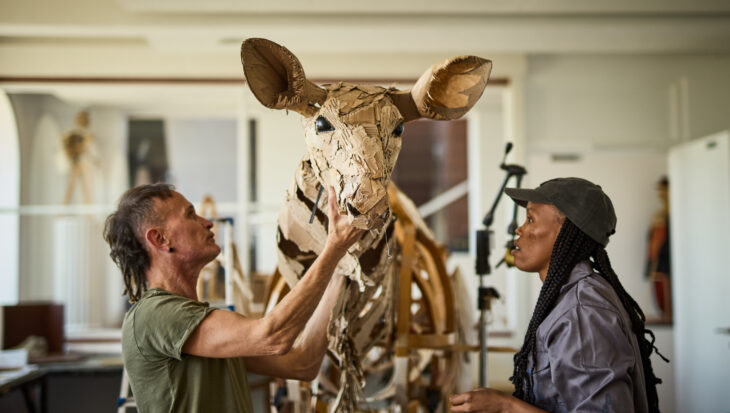‘The Herds’ will be arriving in London this Friday!
Have you heard? A breathtaking arts initiative, ‘The Herds’ will be arriving in London this Friday.
Posted 27 Jun 2025

Posted on the 10th March 2008
Six sick and ailing chickens were rescued from an intensive ‘broiler’ shed and taken to a vet last week during the course of an Animal Aid undercover investigation into modern broiler bird production.
The national campaign group had made three previous visits to the 30,000-bird capacity unit, which is typical of such establishments across Britain. The farm held a total of more than 150,000 birds.
The visits were conducted in order to film the alarmingly swift ‘progress’ of the birds from lively chicks to bloated, lethargic and virtually immobilised inhabitants of a shed that – because of their rapid growth – now offered them virtually no room in which to move.
On the last visit, the birds were still only 39 days old. Yet, within three days, they were to be loaded onto lorries and taken to a killing factory.
Shed records showed that about 1,500 chickens had died or been ‘culled’ within the unit. Despite the victims being removed daily by workers, numerous dead birds were filmed by the national campaign group. Some were heaped into bins, others were found on the shed floor.
Celebrity chefs Jamie Oliver and Hugh Fearnley-Whittingstall have recently drawn welcome attention to the suffering of broiler chickens. But their ‘solution’ has been to promote so called ‘high welfare’ production systems. These offer the birds a little more space, or make use of chickens selectively bred to grow more slowly in an attempt to reduce the burden on their leg joints and lungs. In a recent letter to Jamie and Hugh, Animal Aid Director Andrew Tyler argued that ‘high welfare’ systems ‘can only ever have a marginal impact’ and that the ‘fundamental problem is the commodification of these birds… Animal Aid believes that it is cruel and immoral to treat animals as commodities, which is why we promote the non-animal diet.’
The shocking filmed evidence Animal Aid has gathered on our recent multiple visits to the broiler farm reveals precisely what happens when animals are treated as commodities.
Says Animal Aid Head of Campaigns Kate Fowler-Reeves, who led the undercover team:
‘Witnessing so many animals suffering without any hope of release was overwhelming. Dead and dying birds littered the sodden floor, while live ones limped and fell over them. This terrible existence is endured by hundreds of millions of birds every year in this country alone. But for five of the six birds we were able to remove, there remains hope. One girl – who we found huddled and dehydrated beneath a feed dispenser – sadly did not survive. But another, who was found sprawled across the shed floor, gasping for breath, has responded well to treatment and is slowly recovering her strength. The other four had legs and joints so painfully inflamed that they could not stand or walk, but over the weekend ventured into the sunlight for the very first time in their lives. For these birds, it’s a happy ending; but for the 30,000 who shared a shed with them, there was yet more suffering to endure. Sick, lame and distressed, these birds – who are just 42 days old – were sent to slaughter.’
The poultry industry is divided into two main sectors: egg and meat production. Laying hens are a strain bred specifically for high volume egg production. ‘Broiler’ chickens have been manipulated, through selective breeding techniques, to make them grow at around twice their natural rate. They grow so big and so fast that their legs are unable to support their weight and they frequently collapse. Broilers are slaughtered at just six weeks of age – when they are still immature.
Around 855 million chickens are slaughtered annually in the UK for an industry worth about £2bn a year. Approximately 95 per cent of these birds are intensively farmed inside huge sheds. By the end of the growing cycle, each bird has only 0.5 square ft of floor space and must push his or her way through a solid mass of other chickens to reach food and water points. Because serious leg problems are endemic, many die in the attempt.
They are also vulnerable to heart attacks, septicaemia, and to fatty livers and kidneys. They additionally suffer a high incidence of deformities, caused by arthritis, together with the stress of carrying so much weight on young bones. Nearly one-third have difficulty in walking or cannot walk at all, despite the fact that many of the weaker birds are ‘culled’ inside the sheds.
Many broiler chickens also die from ascites: their growth rate is so rapid that their heart, lungs and circulatory system struggle to maintain sufficient oxygen levels. This results in breathlessness and distended abdomens caused by a build-up of yellow or bloodstained fluid. Respiratory or heart failure kills one in 20 birds.
For more comprehensive broiler industry background information, read our factfile.
Have you heard? A breathtaking arts initiative, ‘The Herds’ will be arriving in London this Friday.
Posted 27 Jun 2025

As the greyhound racing industry releases its annual data on the number of dogs’ deaths, a raft of well-known names - alongside their canine friends - has called upon the Government to end greyhound racing....
Posted 26 Jun 2025
